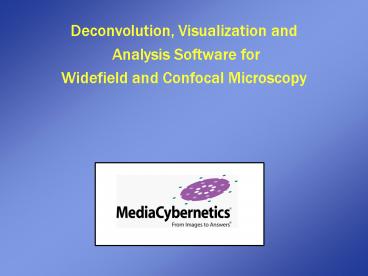Deconvolution, Visualization and - PowerPoint PPT Presentation
1 / 30
Title:
Deconvolution, Visualization and
Description:
Media Cybernetics is committed to delivering the most advanced algorithms ... Microscopy: biomedical research, ophthalmology, medical diagnostics, nuclear ... – PowerPoint PPT presentation
Number of Views:42
Avg rating:3.0/5.0
Title: Deconvolution, Visualization and
1
- Deconvolution, Visualization and
- Analysis Software for
- Widefield and Confocal Microscopy
2
- Media Cybernetics is committed to delivering the
most advanced algorithms available on the market
today by the cutting edge research to develop the
most advanced algorithms for tomorrow.
Media Cybernetics provides uncompromised results
with faster performance than ever before.
The best just keeps getting better and faster
3
Deconvolution A crash course
4
Why Deconvolution ?
Diffraction and aberration in the optical path
lead to Blur / Haze
Each single plane contains blur from planes above
and below PSF 3D representation you get when
imaging a sub-resolution latex bead
3-D diffraction pattern ( Point Spread Function
PSF)
z
5
What is Deconvolution ?
Deconvolution is a computational procedure
that restores the quality of images.
- Usage
- Microscopy biomedical research, ophthalmology,
medical diagnostics, nuclear imaging (CT), food
processing, forensics, skin care/beauty product
development, etc. - Astronomy telescope imaging, satellite imaging,
aerial imaging (cartography), etc. - Industrial Quality control for printed circuit
boards and semiconductors, etc.
6
Benefits of Deconvolution
(Spirogyra)
1. Haze removal ? More contrast ? Better
segmentation 2. Improved resolution ? More detail
revealed 3. Access to depth information 4.
Produces quantitative results (non-destructive)
7
AlgorithmsDeblurring or Deconvolution ?
8
Deconvolution vs. Deblurring
- Deconvolution
- More closely approximates a reversal of the
blurring process - Produces Quantitative results (reverses blurring
accurately) - Better representation of actual morphology
- Deblurring
- Can make images look better fast.
- Results are strictly qualitative
- Produces artifacts
- Morphologically unreliable.
9
Qualitative vs. Quantitative
- No-Neighbors Single slice haze removal.
- Nearest-Neighbors Haze removal from a few
optical sections. - Inverse filtering Inversion of the haze using a
theoretical PSF.
Constrained iterative Iterative deconvolution
with a fixed PSF.
Maximum likelihood Max likelihood estimate-based
iterative deconvolution with a fixed
PSF. Adaptive blind Max likelihood
estimate-based iterative deconvolution
deconvolution deriving the PSF
from information found in the haze itself.
10
No/Nearest Neighbors
- Uses center slice and two adjacent slices
- Estimate amount of blur that adjacent slices
contribute to center slice - Subtract away the blur (remove photons)
- Deblur one slice at a time
- Fast, 2D, only qualitative (unsharp mask)
-z
0
z
11
Inverse/Wiener Filter
- Restoration algorithm looks at whole structure
- Works well on large objects
- Fast, 3D, qualitative
- Regularization/Stability
Imaging
Image
Object
PSF
Inverse Filter
1
Deblurred
Image
PSF
12
Constrained Iterative Deconvolution
- Requires PSF (theoretical or measured)
- Iteratively improve object estimate
- Impose constraints (non-negativity)
- Requires highly optimized imaging system
Object Estimate
Original Blurred
-
Reblurred
PSF
Improved Estimate
Update
Error
13
Iterative Blind Deconvolution
- Estimate both PSF and Object!
- Need microscope parameters (NA, RI, xyz, ?)
- Theoretical PSF with spatial/spectral constraints
- Object with non-negativity and noise constraints
Original Blurred
Object Estimate
Update Object
Update PSF
PSF Estimate
14
Why AQI and Blind Deconvolution ?
- Ease of Use
- No need to image beads and measure PSF
- Much less expertise required by the user
- Less time required on the microscope
- Allows for processing of existing data
- Runs on PC
- Allows for deconvolution of large images
- The reconstructed PSF can vary over the volume
- Disadvantages
- More processing time
15
When to use what?
- When Speed Haze removal are important
- No Neighbor
- Nearest Neighbor
- Inverse Filter
- 3D Deconvolution
- When Quality Quantitation are critical
16
XY Max Projections
XZ Max Projections
XY Max Projections
XZ Max Projections
17
3D Blind Deconvolution
Drosophila larvae leg
18
3D Blind Deconvolution
19
Blind deconvolution 3D Confocal
20
Blind deconvolution 3D Confocal
21
2D Blind deconvolution TIRF
22
Blind deconvolution (with Spherical aberration
correction)
23
How do I know its real?
24
Optical Slices
raw
deblurred
slice 37
slice 29
25
2D Blind
26
2D Blind Deconvolution true iterative blind
deconvolution
- No image parameters required
- Ideal for optically thin specimens
- Assumes everything is in one plane of focus
27
2D Blind Deconvolution
- 2D deconvolution on a 3D volume
28
Why Deconvolve?
- Improved resolution of small features
- Better definition of structure in multiple
dimensions - More accurate localization of intensity for
quantification and ratiometry - Signal to noise (SNR) improvement
29
Why Media Cybernetics
- Established technological focus in deconvolution
over 25 years of dedicated research - Breadth of algorithms that are well known and
accepted world-wide optimized for maximum
robustness - Media Cybernetics stands behind all of its
products and provides world class education and
support. - Committed focus to deconvolution, visualization
and analysis RD ensures customer access to the
latest technologies for today and tomorrow.
30
Media CyberneticsOffering complete
post-processing solutions
- Image improvement, restoration, visualization and
analysis that facilitates more accurate and
compelling results. - Media Cybernetics creates the tools to help you
do the science. - AQI Product Line
- AutoDeblur (2D, Silver, Gold)
- AutoVisualize (with improved 3D-Viewer)
- AutoAnalyze (FRET, Ratio, Object
Counting/Tracking, Colocalization) - Tools (automatic, manual and channel-channel
alignment) - Image-Pro Product Line
- Image-Pro Plus and Image-Pro Plug-In module
bundles - Express
- Analyzer































